
95% of researchers rate our articles as excellent or good
Learn more about the work of our research integrity team to safeguard the quality of each article we publish.
Find out more
ORIGINAL RESEARCH article
Front. Chem. , 01 December 2020
Sec. Supramolecular Chemistry
Volume 8 - 2020 | https://doi.org/10.3389/fchem.2020.613932
This article is part of the Research Topic Supramolecular Chirogenesis in Chemical and Related Sciences View all 15 articles
 Kumiko Nishinaka1
Kumiko Nishinaka1 Jiandong Han2
Jiandong Han2 Dongli Han2
Dongli Han2 Yue Liu1
Yue Liu1 Yanqing Du2
Yanqing Du2 Meiling Wang2
Meiling Wang2 Chaolu Eerdun2*
Chaolu Eerdun2* Nobuyasu Naruse3
Nobuyasu Naruse3 Yutaka Mera3
Yutaka Mera3 Yoshio Furusho3
Yoshio Furusho3 Akihiko Tsuda1,2,3*
Akihiko Tsuda1,2,3*Metal-organic 1D-coordination polymers, having unique electronic and optical properties, are expected to be a novel advanced functional material capable of fabricating smart plastics, films, and fibers. In this study, we have synthesized a novel metal-organic 1D-coordination polymer composed of a phenylene-bridged bipyrrole bearing N-alkylimino groups (BPI) and palladium(II) ion. The BPI and Pd(II) form square planar bis(bidentate) complex to form a metal coordinated π-conjugation polymer (Poly-BPI/Pd). It is stable in solutions at room temperature, and allowed measurement of its average molecular weight in SEC (Mw = 106,000 and Mn = 18,000, Mw/Mn = 5.88). It also provided a reversible multi redox profile in cyclic voltammetry, most likely originating from strong π-electronic interactions between the BPI components via Pd ion. A variety of substituent groups can be attached to the imino-nitrogens of BPI. A coordination polymer composed of a BPI derivative bearing chiral alkyl chains and Pd(II) showed strong circular dichroism (CD) in the solution due to the unidirectional chiral conformation of the BPI components in the polymer backbone.
Coordination polymers (CPs) having two- and three-dimensional network structures such as nanosheets, metal-organic frameworks (MOFs), and porous coordination polymers (PCPs) have been actively studied (Wang et al., 2017; Sahadevan et al., 2018; Gu et al., 2019). These materials have attracted intense interests in terms of potential wide applications in catalysis, magnetism, luminescence, electrical conduction, chemical sensing, and especially in gas storage and separation (Sahay et al., 2014; Stavila et al., 2014; Kirchon et al., 2018). On the other hand, less attention has been paid to one-dimensional coordination polymer (1D-CP), which is expected to have characteristic molecular functions originating from its repetitive metal-organic components and softness of the linear polymers (Noro et al., 2009; Liu et al., 2017). In the reported examples, the 1D-CPs appear mainly in the solid-state, but readily dissociate into the constitutive ligands and metals and/or aggregate randomly in solution. For this reason, it is a challenging subject to isolate and functionalize the metal-organic 1D-CP in the solution. As a limited example, Nishihara and coworkers reported 1D-CPs comprising bridging dipyrrin ligands and divalent metal ions (Zn2+, Ni2+, and Cu2+) (Matsuoka et al., 2015). Their 1D-CPs are stable in solution but include a non-conjugated chromophoric ligand that allows weak electronic communications over the polymer backbone. In the present study, with an expectation to increase the electronic interactions between the components, which provides unique electronic and optical properties, we have designed a novel metal-organic 1D-CP with a π-conjugated ligand and metal ion.
We previously reported the synthesis of a π-conjugated phenylene-bridged bipyrrole bearing N-alkylimino groups (BPI-1), and found that it is an acid-responsive single trichromatic luminescent dye capable of emitting pure white light (WL) (Imamura et al., 2017). The blue-light-emitting BPI-1 exhibits dramatic color changes in fluorescence to orange and green upon mono- and diprotonation, respectively, providing a wide emission band in the range of λ = 400–800 nm that provide WL when the compound is in a dynamic equilibrium between the three states. With this BPI-1 and its derivatives as a π-conjugated organic component (bis-bidentate ligand), we have newly designed and synthesized metal-organic 1D-CPs upon complexation with palladium(II) ion (Poly-BPI/Pd). N-Substituted pyrrole-2-aldimines are known to form metal complexes with transition metal ions (Figure 1A) (Holm et al., 1966; Yeh and Barker, 1967). We expected that the BPI monomers are directly connected with Pd(II) ions to form square-planar bis(bidentate) complexes to form a metal coordinated π-conjugation polymer (Figure 1B). We found, herein, that Poly-BPI/Pd is stable in the solutions at room temperature and shows a reversible multi redox behavior. Further, its derivative having chiral alkyl chains shows strong circular dichroism (CD) in the solution due to the unidirectional chiral conformation of the BPI components in the polymer backbone.
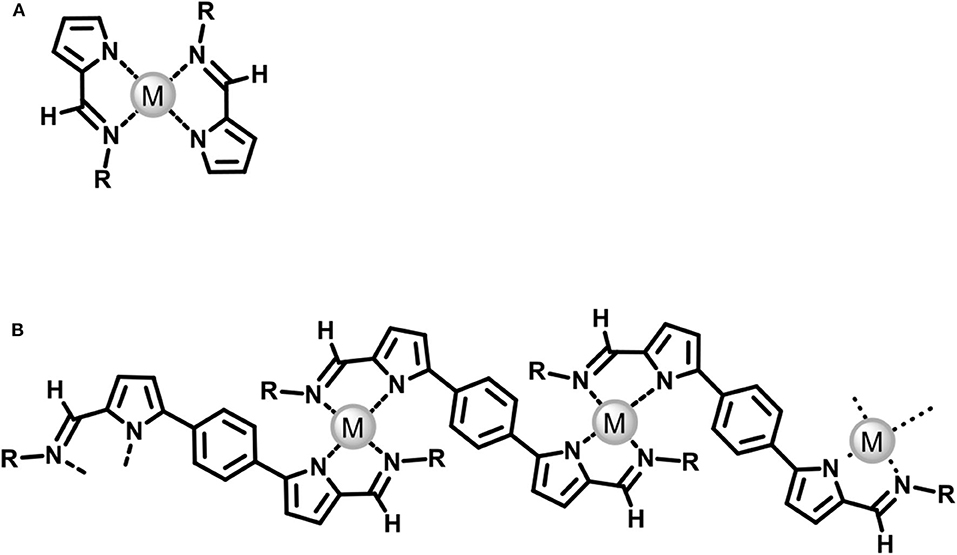
Figure 1. (A) 2:1 complex of N-substituted pyrrole-2-aldimines and transition metal ion reported previously, (B) 1:1 complex of bis(N-substituted pyrrole-2-aldimines) and transition metal ion studied in this study.
We synthesized imino-substituted bipyrrole derivatives BPI-1–4, containing a 1,4-phenylene spacer according to the previously reported procedures Scheme 1 (Setsune et al., 2015). BPF bearing formyl groups at pyrrolic α-positions were synthesized in advance. Then, the formyl groups were converted to the corresponding imines bearing various functional groups on the nitrogen atom through condensation reactions with the amine in the presence or absence of an acid catalyst (isolated yields 75–96 %).
We initially attempted the synthesis of 1D-CPs with BPI-1, bearing N-benzyl groups, and transition metal salts such as Zn(OAc)2, Cu(OAc)2, and Pd(OAc)2. BPI-1 and metal salt were mixed in a 1:1 ratio in a mixture solution of CH2Cl2/CH3OH (5:1) and stirred overnight at room temperature. In these experiments, only the sample solution containing BPI-1 and Pd(OAc)2 provided a precipitate, which is slightly soluble into organic solvents such as CHCl3 and CH2Cl2, likely due to the complexation. 1H NMR spectrum of BPI-1 in CDCl3 provides characteristic singlet signals corresponding to the protons on imine, phenylene, and benzyl groups at δ = 8.27, 7.49, and 4.73 ppm, respectively (Figure 2). These peaks become broad and are shifted to the higher magnetic field region at 8.01, 7.33–6.97, and 3.36 ppm, respectively, upon complexation with Pd(II) ion. Similar changes were observed for other peaks corresponding to the phenyl and ethyl exteriors. These 1H NMR spectral features indicate the formation of the certain polymers (Berl et al., 2002).
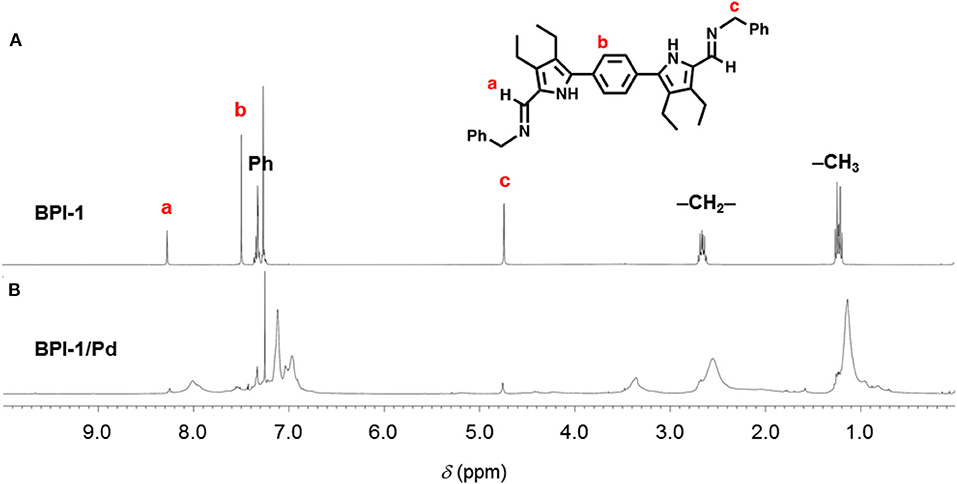
Figure 2. 1H NMR spectra (400 MHz, CDCl3) of (A) BPI-1 and (B) a product formed upon mixing BPI-1 and Pd(OAc)2 at 1:1 ratio.
On the other hand, in UV-Vis absorption spectroscopy, BPI-1 showed a large red-shift of its lowest energy absorption band from λmax = 368 nm to 419 nm in CH2Cl2 upon complexation with Pd(II) (Figure 3), which may mainly originate from exciton coupling of BPI-1 array, owing to the electric transition dipole for the long-axis polarized π–π* transition (vide infra) (Ahmad et al., 2009; Li et al., 2019). Further, the emission spectrum of BPI-1, observed at 400–600 nm with λmax = 426 and 450 nm, disappeared upon the complexation. This observed quenching behavior may be ascribed to the heavy atom effect due to Pd ion (Drzewiecka-Matuszek et al., 2005). These observed spectral features strongly indicate the formation of a metal-organic CP. However, its low solubility into organic solvents does not allow measurement of the average molecular weight in SEC.

Figure 3. (A) UV-Vis absorption spectra and (B) fluorescence spectra upon excitation at 350 nm of BPI-1 and BPI-1/Pd complex in CH2Cl2 at 25°C. [BPI-1] = 2.28 × 10−5 M, [BPI-1/Pd complex] = 1.92 × 10−5 M. *Stray light.
We then synthesized BPI-2, having N-dodecyl chains, to increase the solubility of the product into organic solvents. BPI-2 was mixed with 2 equiv. amounts of Pd(OAc)2 in CH2Cl2, and stirred for 2 days at room temperature to give the complex soluble into organic solvents such as CHCl3 and CH2Cl2. The BPI-2/Pd complex was thus isolated through extraction with CH2Cl2 and water to give a film-like solid after evaporation of the solvent (Figure 4A). Spectral changes of BPI-2 in 1H NMR, UV-Vis absorption, and fluorescence spectroscopies upon complexation with Pd(II) were almost the same as those observed in BPI-1 as described above (Supplementary Figures 1, 2). BPI-2/Pd is stable in solutions and was subjected to the SEC measurements to estimate average molecular weight. SEC was conducted with CHCl3 as an eluent, and it revealed that BPI-2/Pd complex has shorter retention time (13.4 min) than BPI-2 monomer (23.5 min) (Figure 4B). The average molecular weight of BPI-2/Pd complex was estimated to be Mw = 106,000 (corresponding to 130 mer) and Mn = 18,000, Mw/Mn = 5.88 compared to polystyrene standards. As an experimental reference data, dynamic light scattering (DLS) measurement of BPI-2/Pd complex provided an average particle size of 372 nm with a size distribution of 143–2,114 nm in CHCl3 (Supplementary Figure 3). These results indicate that BPI/Pd complexes have polymeric structures.

Figure 4. (A) Photos of film-like solid samples of BPI-2/Pd complex. (B) SEC profiles of BPI-2 and BPI-2/Pd complex monitored at 424 and 420 nm, respectively, in SEC. [Conditions] Column: TOSOH TSKgel G4000HXL + G4000HHR, Solvent: CHCl3, Flow speed: 1 mL/min, Temperature: 20°C.
The electrochemical properties, especially for oxidation, of the metal-organic 1D-CP, were studied by cyclic voltammetry (CV) in CH2Cl2 containing 0.1 M tetrabutylammonium perchlorate (Bu4NClO4) as supporting electrolyte. The cyclic voltammograms (V vs. Fc/Fc+) of BPI-2 monomer and BPI-2/Pd polymer are shown in Figure 5. BPI-2 showed an irreversible oxidation peak at around 0.8 V, where the oxidation may bring about the chemical reaction and/or decomposition of the imine groups. Differential pulse voltammetry (DPV) also provided the corresponding peak at 0.78 V (Supplementary Figure 4A). However, in sharp contrast, BPI-2/Pd polymer provided reversible multi redox peaks in CV at around E1/2 = 0.35 and 0.5 V, where the electrochemical properties of imino group may be changed upon complexation with Pd(II) ion. DPV also provided the corresponding two peaks at 0.33 and 0.50 V, respectively (Supplementary Figure 4B). This observed multi-redox behavior of BPI-2/Pd polymer could be explained by the π-electronic interactions between bipyrrole ligands via Pd(II) ion (Hildebrandt et al., 2011). The positive charge generated upon first oxidation on the polymer backbone withdraw π-electrons of other BPI ligands via the metal ions, resulting in a positive shift of their oxidation potential to give the multi redox profile.
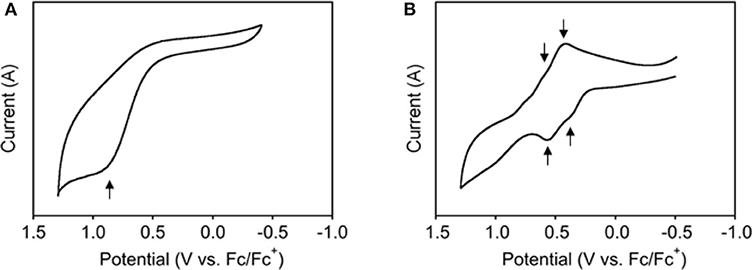
Figure 5. Cyclic voltammograms (V vs. Fc/Fc+) of (A) BPI-2 and (B) BPI-2/Pd polymer in CH2Cl2. Scan rate, 100 mV/s; working electrode, Pt; supporting electrolyte, 0.1 M Bu4NClO4.
BPI can attach a variety of substituent groups on imino-nitrogens. We have previously synthesized N-hexyl BPI and found in the crystal structure that two pyrrole components adopt a twisted geometry with an anti-folded confirmation through the phenylene spacer (Ie et al., 2015). The dihedral angle of pyrrole and phenylene components is 33.3° on average, owing to the steric repulsions between the ethyl group attached to the pyrrole-β and phenylene ring (Li et al., 2020). This observed twisted structure allows our expectation that BPI/Pd polymer can form a helical CP by attachment of chiral substituent groups on imino-nitrogens (Huang et al., 2018; Wang et al., 2019; Zhou et al., 2020).
We then synthesized BPI-3(R) and BPI-3(S), having chiral alkyl chains on imino-nitrogens. BPI-3, upon mixing with Pd(OAc)2, also formed the coordination polymer under the same conditions of synthesizing BPI-2/Pd polymer (Supplementary Figure 5). However, their average molecular weights [BPI-3(R)/Pd, Mw = 10,900, Mn = 6,800, Mw/Mn = 1.60; BPI-3(S)/Pd, Mw = 8,600, Mn = 4,700, Mw/Mn = 1.80] are clearly lower than that of BPI-2/Pd polymer (Supplementary Figure 6). The 1-methyl group attached to the N-alkyl chain may increase steric crowdness around metal-ligand coordination bonds to decrease the polymerization degree of the CP (Guzei and Wendt, 2006; Talarico and Budzelaar, 2008). Here, BPI components may adopt a chiral conformation in the resulting polymer structure.
In circular dichroism (CD) spectroscopy, BPI-3(R) and BPI-3(S) ligands showed weak CD spectra with λmax at 425 nm (Figure 6). However, interestingly, strong CD responses with Cotton effects appeared in their coordination polymers. BPI-3(R)/Pd and BPI-3(S)/Pd showed negative to positive and positive to negative Cotton effects, respectively, at the lowest energy absorption band to give the mirror-imaged CD profiles in each other. These observed spectral features may originate from exciton-coupled CD owing to the helical orientation of BPI-3 ligands in the 1D-polymeric structure as schematically illustrated in Figure 7. Their Cotton effects allow empirical estimation of their absolute configurations (Gonnella et al., 1982; Furo et al., 2005; Telfer et al., 2011). BPI-3(R)/Pd and BPI-3(S)/Pd may dominantly adopt (S)- and (R)-configuration, which allows the formation of P- and M-helical coordination polymer, respectively.
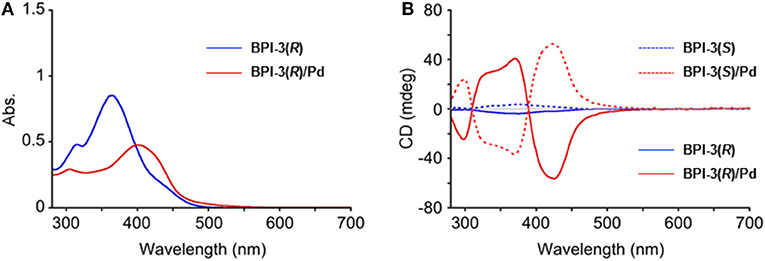
Figure 6. (A) UV-Vis absorption spectra of BPI-3(R) and BPI-3(R)/Pd polymer and (B) CD spectra of BPI-3(R), BPI-3(S), BPI-3(R)/Pd polymer, and BPI-3(S)/Pd polymer in CH2Cl2 at 25°C. [BPI-3] = 3.29 × 10−5 M, [BPI-3/Pd polymer (monomer)] = 3.11 × 10−5 M.
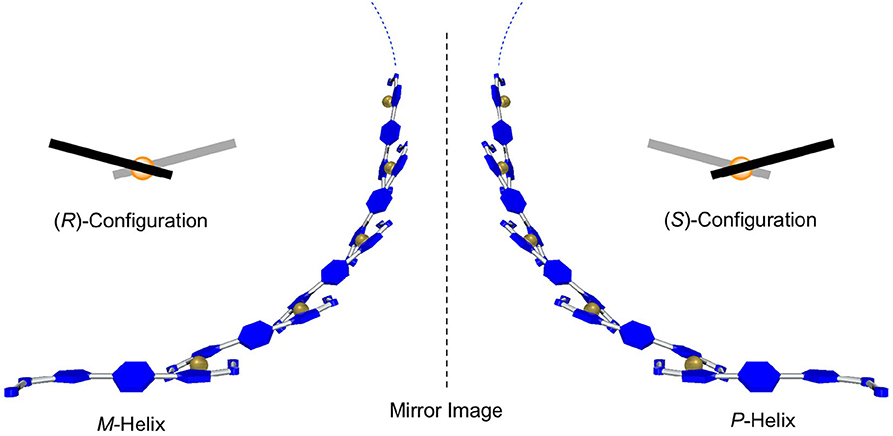
Figure 7. Schematic illustrations of helical polymer structures of BPI-3(R)/Pd (Right) and BPI-3(S)/Pd (Left) expected from exciton coupled CD spectra in Figure 6B.
Next, we synthesized a coordination copolymer (CCP) with a 1:5 mixture of chiral BPI-3(R) and achiral BPI-4 upon mixing with Pd(OAc)2 through the similar procedures to the synthesis of the above polymers. The polymer was obtained in 72% yield and characterized using 1H NMR, UV-Vis absorption, and CD spectra and SEC. The SEC profile provided only a broad single peak, a typical polydispersion profile of the polymer, indicating random copolymerization. Its average molecular weight is estimated to be Mw = 11,100 and Mn = 6,300, Mw/Mn = 1.76 compared to polystyrene standards in SEC. Hence, its sample solution in CH2Cl2 was CD active, and the spectral pattern observed was essentially the same as that of BPI-3(R)/Pd polymer. However, since the spectral intensity is ~4–5 times smaller, it seems that the local chiral twisted conformations occurred in BPI-3(R)/Pd complexation in the copolymer is not amplified on the resulting polymer backbone. The p-phenylene-spacer of BPI unit, which provides a distance between its substituent groups, likely allows the polymerization without steric repulsions and/or interactions of the chiral metal-coordination moieties.
In this study, we have synthesized a novel metal-organic 1D-coordination polymer composed of a phenylene-bridged bipyrrole bearing N-alkylimino groups and palladium(II) ion. Although most of 1D-CPs reported are unstable in solutions, BPI and Pd(II) ion form a metal coordinated π-conjugation polymer, which is stable in the solutions. BPI/Pd polymer showed π-electronic communications between the BPI components via Pd(II) ion in its polymer structure to give exciton coupling in the absorption spectrum. Further it allowed a reversible multi redox in cyclic voltammetry. BPI-3/Pd polymer having chiral alkyl chains on the imino-nitrogen showed strong circular dichroism (CD) owing to its one-handedly twisted helical polymer structure. We can expect a variety of the molecular functions through structural modifications of N-substituent groups, metal ion, and aromatic spacer, and control of the polymerization degree of this metal-organic 1D-coordination polymer.
The raw data supporting the conclusions of this article will be made available by the authors, without undue reservation.
All authors listed have made a substantial, direct and intellectual contribution to the work, and approved it for publication.
This present work was sponsored by Grants-in-Aid for Scientific Research (B) (No. 17H02740) from the Ministry of Education, Science, Sports, and Culture, Japan, and National Natural Science Foundation of China (No. 21961026) from the Ministry of Science and Technology, China.
The authors declare that the research was conducted in the absence of any commercial or financial relationships that could be construed as a potential conflict of interest.
The Supplementary Material for this article can be found online at: https://www.frontiersin.org/articles/10.3389/fchem.2020.613932/full#supplementary-material
Ahmad, R., Wong-Foy, A. G., and Matzger, A. J. (2009). Microporous coordination polymers as selective sorbents for liquid chromatography. Langmuir 25, 11977–11979. doi: 10.1021/la902276a
Berl, V., Schmutz, M., Krische, M. J., Khoury, R. G., and Lehn, J. M. (2002). Supramolecular polymers generated from heterocomplementary monomers linked through multiple hydrogen-bonding arrays-formation, characterization, and properties. Chem. Eur. J. 8, 1227–1244. doi: 10.1002/1521-3765(20020301)8:5<1227::AID-CHEM1227>3.0.CO;2-0
Drzewiecka-Matuszek, A., Skalna, A., Karocki, A., Stochel, G., and Fiedor, L. (2005). Effects of heavy central metal on the ground and excited states of chlorophyll. J. Biol. Inorg. Chem. 10, 453–462. doi: 10.1007/s00775-005-0652-6
Furo, T., Mori, T., Wada, T., and Inoue, Y. (2005). Absolute configuration of chiral [2.2] paracyclophanes with intramolecular charge-transfer interaction. Failure of the exciton chirality method and use of the sector rule applied to the cotton effect of the CT transition. J. Am. Chem. Soc. 127, 8242–8243. doi: 10.1021/ja0508323
Gonnella, N. C., Nakanishi, K., Martin, V. S., and Sharpless, K. B. (1982). General method for determining absolute configuration of acyclic allylic alcohols. J. Am. Chem. Soc. 104, 3775–3776. doi: 10.1021/ja00377a063
Gu, J., Wen, M., Cai, Y., Shi, Z., Nesterov, D. S., Kirillova, M. V., et al. (2019). Cobalt (II) coordination polymers assembled from unexplored pyridine-carboxylic acids: structural diversity and catalytic oxidation of alcohols. Inorg. Chem. 58, 5875–5885. doi: 10.1021/acs.inorgchem.9b00242
Guzei, I. A., and Wendt, M. (2006). An improved method for the computation of ligand steric effects based on solid angles. Dalton Trans. 33, 3991–3999. doi: 10.1039/b605102b
Hildebrandt, A., Pfaff, U., and Lang, H. (2011). 5-Membered heterocycles with directly-bonded sandwich and half-sandwich termini as multi-redox systems: synthesis, reactivity, electrochemistry, structure and bonding. Rev. Inorg. Chem. 31, 111–141. doi: 10.1515/REVIC.2011.008
Holm, R. H., Chakravorty, A., and Theriot, L. J. (1966). The synthesis, structures, and solution equilibria of bis(pyrrole-2-aldimino)metal(II) complexes. Inorg. Chem. 5, 625–635. doi: 10.1021/ic50038a028
Huang, J., Shen, L., Zou, H., and Liu, N. (2018). Enantiomer-selective living polymerization of rac-phenyl isocyanide using chiral palladium catalyst. Chinese J. Polym. Sci. 36, 799–804. doi: 10.1007/s10118-018-2136-5
Ie, M., Setsune, J., Eda, K., and Tsuda, A. (2015). Chiroptical sensing of oligonucleotides with a cyclic octapyrrole. Org. Chem. Front. 2, 29–33. doi: 10.1039/C4QO00268G
Imamura, K., Ueno, Y., Akimoto, S., Eda, K., Du, Y., Eerdun, C., et al. (2017). An acid-responsive single trichromatic luminescent dye that provides pure white-light emission. ChemPhotoChem. 1, 427–431. doi: 10.1002/cptc.201700108
Kirchon, A., Feng, L., Drake, H. F., Joseph, E. A., and Zhou, H.-C. (2018). From fundamentals to applications: a toolbox for robust and multifunctional MOF materials. Chem. Soc. Rev. 47, 8611–8638. doi: 10.1039/C8CS00688A
Li, C., Zhang, K., Ishida, M., Li, Q., Shimomura, K., Baryshnikov, G., et al. (2020). Tripyrrin-armed isosmaragdyrins: synthesis, heterodinuclear coordination, and protonation-triggered helical inversion. Chem. Sci. 11, 2790–2795. doi: 10.1039/C9SC06197E
Li, G., Fan, C., Cheng, G., Wu, W., and Yang, C. (2019). Synthesis, enantioseparation and photophysical properties of planar-chiral pillar [5] arene derivatives bearing fluorophore fragments. Beilstein J. Org. Chem. 15, 1601–1611. doi: 10.3762/bjoc.15.164
Liu, M., Quah, H. S., Wen, S., Wang, J., Kumar, P. S., Eda, G., et al. (2017). Nonlinear optical properties of a one-dimensional coordination polymer. J. Mater. Chem. C 5, 2936–2941. doi: 10.1039/C6TC05372F
Matsuoka, R., Toyoda, R., Sakamoto, R., Tsuchiya, M., Hoshiko, K., Nagayama, T., et al. (2015). Bis (dipyrrinato) metal (II) coordination polymers: crystallization, exfoliation into single wires, and electric conversion ability. Chem. Sci. 6, 2853–2858. doi: 10.1039/C5SC00273G
Noro, S., Tanaka, D., Sakamoto, H., Shimomura, S., Kitagawa, S., Takeda, S., et al. (2009). Selective gas adsorption in one-dimensional, flexible CuII coordination polymers with polar units. Chem. Mater. 21, 3346–3355. doi: 10.1021/cm9012969
Sahadevan, S. A., Monni, N., Abhervé, A., Marongiu, D., Sarritzu, V., Sestu, N., et al. (2018). Nanosheets of two-dimensional neutral coordination polymers based on near-infrared-emitting lanthanides and a chlorocyananilate ligand. Chem. Mater. 30, 6575–6586. doi: 10.1021/acs.chemmater.8b03399
Sahay, R., Reddy, V. J., and Ramakrishna, S. (2014). Synthesis and applications of multifunctional composite nanomaterials. Int. J. Mech. Mater. Eng. 9:25. doi: 10.1186/s40712-014-0025-4
Setsune, J., Toda, M., Yoshida, T., Imamura, K., and Watanabe, K. (2015). The synthesis and dynamic structures of multinuclear complexes of large porphyrinoids expanded by phenylene and thienylene spacers. Chem. Eur. J. 21, 12715–12727. doi: 10.1002/chem.201501570
Stavila, V., Talin, A. A., and Allendorf, M. D. (2014). MOF-based electronic and opto-electronic devices. Chem. Soc. Rev. 43, 5994–6010. doi: 10.1039/C4CS00096J
Talarico, G., and Budzelaar, P. H. M. (2008). Variability of chain transfer to monomer step in olefin polymerization. Organometallics 27, 4098–4107. doi: 10.1021/om800313n
Telfer, S. G., McLean, T. M., and Waterland, M. R. (2011). Exciton coupling in coordination compounds. Dalton Trans. 40, 3097–3108. doi: 10.1039/c0dt01226b
Wang, H.-Y., Cui, L., Xie, J.-Z., Leong, C. F., D'Alessandro, D. M., and Zuo, J.-L. (2017). Functional coordination polymers based on redox-active tetrathiafulvalene and its derivatives. Coord. Chem. Rev. 345, 342–361. doi: 10.1016/j.ccr.2016.10.011
Wang, Y., Chen, Y., Jiang, Z., Liu, F., Liu, F., Zhu, Y., et al. (2019). Halogen effects on phenylethynyl palladium (II) complexes for living polymerization of isocyanides: a combined experimental and computational investigation. Sci. China Chem. 62, 491–499. doi: 10.1007/s11426-018-9415-8
Yeh, K.-N., and Barker, R. H. (1967). Synthesis and properties of some metal chelates of 2-pyrrole aldimines. Inorg. Chem. 6, 830–833. doi: 10.1021/ic50050a037
Keywords: coordination polymer, helical polymer, complex, π-conjugation, chirality
Citation: Nishinaka K, Han J, Han D, Liu Y, Du Y, Wang M, Eerdun C, Naruse N, Mera Y, Furusho Y and Tsuda A (2020) A Chiral Metal-Organic 1D-Coordination Polymer Upon Complexation of Phenylene-Bridged Bipyrrole and Palladium (II) Ion. Front. Chem. 8:613932. doi: 10.3389/fchem.2020.613932
Received: 04 October 2020; Accepted: 06 November 2020;
Published: 01 December 2020.
Edited by:
Cheng Yang, Sichuan University, ChinaReviewed by:
Zong-Quan Wu, Hefei University of Technology, ChinaCopyright © 2020 Nishinaka, Han, Han, Liu, Du, Wang, Eerdun, Naruse, Mera, Furusho and Tsuda. This is an open-access article distributed under the terms of the Creative Commons Attribution License (CC BY). The use, distribution or reproduction in other forums is permitted, provided the original author(s) and the copyright owner(s) are credited and that the original publication in this journal is cited, in accordance with accepted academic practice. No use, distribution or reproduction is permitted which does not comply with these terms.
*Correspondence: Chaolu Eerdun, MjAwMzAwOTFAaW1tdS5lZHUuY24=; Akihiko Tsuda, dHN1ZGFAaGFyYm9yLmtvYmUtdS5hYy5qcA==
Disclaimer: All claims expressed in this article are solely those of the authors and do not necessarily represent those of their affiliated organizations, or those of the publisher, the editors and the reviewers. Any product that may be evaluated in this article or claim that may be made by its manufacturer is not guaranteed or endorsed by the publisher.
Research integrity at Frontiers

Learn more about the work of our research integrity team to safeguard the quality of each article we publish.